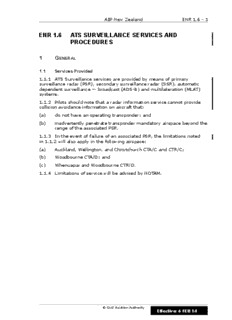
ENR 1.6 RADAR SERVICE AND PROCEDURES - AIP New Zealand PDF
Preview ENR 1.6 RADAR SERVICE AND PROCEDURES - AIP New Zealand
AIPNewZealand ENR1.6-1 ENR 1.6 ATS SURVEILLANCE SERVICES AND PROCEDURES 1 GENERAL 1.1 ServicesProvided 1.1.1 ATSSurveillanceservicesareprovidedbymeansofprimary surveillanceradar(PSR),secondarysurveillanceradar(SSR),automatic dependentsurveillance—broadcast(ADS-B)andmultilateration(MLAT) systems. 1.1.2 Pilotsshouldnotethataradarinformationservicecannotprovide collisionavoidanceinformationonaircraftthat: (a) donothaveanoperatingtransponder;and (b) inadvertentlypenetratetranspondermandatoryairspacebeyondthe rangeoftheassociatedPSR. 1.1.3 IntheeventoffailureofanassociatedPSR,thelimitationsnoted in1.1.2willalsoapplyinthefollowingairspace: (a) Auckland,Wellington,andChristchurchCTA/CandCTR/C; (b) WoodbourneCTA/D;and (c) WhenuapaiandWoodbourneCTR/D. 1.1.4 LimitationsofservicewillbeadvisedbyNOTAM. ©CivilAviationAuthority Effective:6FEB14 ENR1.6-2 AIPNewZealand 2 PRIMARYSURVEILLANCERADAR(PSR) 2.1 PSRSites 2.1.1 PSRs,withamaximumrangeofupto80NM,arelocatedat: (a) AucklandAirport; (b) ChristchurchAirport;and (c) HawkinsHill(3.5NMwestofWellingtonAirport). D ©CivilAviationAuthority Effective:2SEP04 AIPNewZealand ENR1.6-3 3 SECONDARYSURVEILLANCERADAR(SSR) 3.1 SSRSites 3.1.1 SSRs,withamaximumrangeof256NM,arelocatedatthe followingsites: (a) Ruaotuwhenua 12.5NMnorth-westofAucklandAirport; (b) TeWeraiti KaimaiRange6.5NMeastofMatamataTownship; (c) Ballance TararuaRangebetweenPalmerstonNorth aerodromeandPahiatuaTownship; (d) HawkinsHill 3.5NMwestofWellingtonAirport; (e) MtRobertson 3NMsouth-eastofPictonTownship; (f) CassPeak PortHills9.5NMsouth-eastofChristchurch Airport. 3.1.2 TheSSRsitesareallelevatedtoimprovelowlevelcover.Theyare shownontheappropriatetopographicalcharts. 3.2 Transponders 3.2.1 Transpondersallowpositiveaircraftidentificationandaltitude informationtobedisplayedtoairtrafficcontrol.Thisenablescontrollers toquicklydeterminewherepotentialconflictscouldoccur. 3.2.2 Inaddition,operationoftranspondersatalltimesincreasessafety whenoperatinginthevicinityofACASequippedaircraft,andwillenhance SearchandRescueandemergencyactionwhenoperatingwithin surveillancecover. 3.2.3 AdherencetotransponderoperatingproceduresprovidesbothVFR andIFRaircraftwithahigherdegreeofsafetyandreduces communications,givingamoreefficientservice. 3.2.4 AnaircraftequippedwithModeSwhichhasanaircraftidentification capabilitymusttransmittheaircraftidentificationasspecifiedinItem7of theICAOflightplanor,whennoflightplanhasbeenfiled,theaircraft registration. 3.2.5 AircraftequippedwithModeSmustincludetheModeSaddressin Item18oftheflightplan,e.g.CODE/C81111. ©CivilAviationAuthority Effective:14SEP17 ENR1.6-4 AIPNewZealand 3.2.6 ATCmustverifywiththepilotatleastonceduringtheflightthatthe altitudeinformationreceivedfromthetransponderiscorrect,priortousing thatinformationforseparationpurposes. 3.2.7 ATCwillreceiveanalertwheretheselectedlevelenteredintothe modecontrolpanel/flightcontrolunitofanenhancedsurveillance(EHS) Mode-Sequippedaircraftdoesnotmatchtheclearedlevelissuedbythe controllerorintermediatelevelcontainedintheSRC.ATCwilladvisethe aircraftofthediscrepancy,e.g. “FASTAIR927CHECKSELECTEDLEVEL.CLEAREDLEVELIS10,000FT” 3.3 SystemofSSRCodeAssignment SSRCodeAllocation 3.3.1 SSRcodesareallocatedbyradarequippedATSfacilitiesto controlledflightsoperatingwithintheirareaofresponsibility,andto controlledflightsenteringtheNewZealandFIRfromtheAucklandOceanic FIR. 3.3.2 CodesforuseinNewZealandareallocatedinaccordancewith internationalagreementsandinstructionscontainedintheManualofAir TrafficServices. 3.3.3 Thepilotoperatinganaircraft,notinaformation,intransponder- mandatoryairspacemustsetthetransponder: (a) totheappropriatecodeassignedbyATCfortheflight;or (b) ifnotassignedacodebyATC,inaccordancewithTableENR1.6-1;or (c) ifanin-flightemergency,lossofcommunications,oranunlawful interferenceoccurs,inaccordancewithTableENR1.6-2. ©CivilAviationAuthority Effective:14SEP17 AIPNewZealand ENR1.6-5 TableENR1.6-1 TransponderCodeAllocation Flight TypeofAircraft SSRCode Rules IFR WithinAucklandOceanicFIR: including DepartingNewZealandFIR Codeassignedon Flight departure RulesY andZ InboundtooroverflyingNew Lastcodeassigned, ZealandFIR or2000 WithinNewZealandFIR Codeassigned,or2000 VFR Firesuppressionandreconnaissance 0111 (fixedwingandhelicopters) Civilaeroplanesotherthangliders 1200 Glidersandballoons 1300 AircraftinGeneralAviationAreas 1400 Civilhelicopters 1500 WithinAucklandOceanicFIR 2000 Aircraftoperatinginaerodrometraffic 2200 circuitatcontrolledaerodromes Defenceaeroplanes 6000 Defencehelicopters 6500 TableENR1.6-2 EmergencySSRCodes Occurrence SSRCode Unlawfulinterference 7500 Lossofradiocommunication 7600 In-flightemergencywhennocodehas 7700 beenallocatedbyATC ©CivilAviationAuthority Effective:4SEP03 ENR1.6-6 AIPNewZealand ©CivilAviationAuthority Effective:4SEP03 AIPNewZealand ENR1.6-7 FormationSSRcodesandprocedures 3.3.4 Inmilitaryformations,anindividualSSRcodewillbeassignedto eachaircraftintheformation.Thelastnumberofthecodeshould correspondtotheaircraft’sformationnumbere.g.RED1=6121,RED2= 6122,etc. 3.3.5 Incivilformations,anSSRcodewillbeassignedtotheformation leader,andallotheraircraftwillbeassignedcode2020. 3.3.6 UnlessotherwiseinstructedbyATC,allaircraftintheformationare tosquawkNORMAL,exceptthatwithinairspaceunderthecontrolof Ohakea,theleaderistosquawkNORMALandallotheraircraftareto squawkSTANDBY,unlessotherwiseinstructed. 3.3.7 WheremembersofaformationhavebeeninstructedbyATCto squawkSTANDBYtheformationleadermustadviseATCimmediatelythere isarelaxationorsignificantchange(laterallyorvertically)tothe formation’sconfiguration.ThisistoenableATCtore-evaluateseparation requirementsbetweentheaircraftintheformationandotheraircraft. 3.4 TransponderProceduresforPilots 3.4.1 TheuseofSSRtransponderandaltitudereportingequipmentis prescribedinCAR91.247. 3.4.2 PilotsmustoperatetranspondersinaccordancewithATC instructionsandmustacknowledgebyreadingbackcodesetting instructions. 3.4.3 Pilotsmustnotoperatethe“IDENT”featureunlessinstructedby ATC. 3.4.4 WithintheAucklandOceanicFIR(westof180°)andtheNew ZealandFIR,anaircraftcarrying1090MHzextendedsquitter(1090ES) ADS-BequipmentshalldisableADS-Btransmissionunless: (a) theaircraftemitspositioninformationofanaccuracyandintegrity consistentwiththetransmittedvalueofthepositionquality indicator;or (b) theaircraftalwaystransmitsavalueof0(zero)foroneormoreof thepositionqualityindicators(NUCp,NIC,NACorSIL);or (c) theoperatorhasreceivedspecificdispensationfromtheDirectorof CivilAviation. ©CivilAviationAuthority Effective:3APR14 ENR1.6-8 AIPNewZealand Note1—Thefollowingdocumentsprovideguidancefortheinstallation andairworthinessapprovalofADS-BOUTsystemsinaircraftandensure compliancewitha)above: (i) FAApolicymemoAir-100dated10Oct2012;or (ii) EuropeanAviationSafetyAgency(EASA)AMC20-24;or (iii) FAAACNo.20-165A—AirworthinessApprovalofADS-B;or (iv) ConfigurationstandardsreflectedinAppendixXIofCivilAviation Order20.18oftheCivilAviationSafetyAuthorityofAustralia. Note2—DownlinkedADS-BdatawillnotbeusedbytheATCsystemfor determiningaircraftpositionwhenanyofthepositionqualityindicators (NUCp,NIC,NACorSIL)haveavalueof0(zero). General 3.4.5 Thepilotofanaircraftwhohasreceivedspecificinstructions concerningthetranspondersetting,orwhoisoperatingaVFRcodein transpondermandatoryairspace,must,unlesscomplyingwithemergency procedures,maintainthatsettinguntilotherwiseadvisedbyanATSunit. IFR 3.4.6 AllaircraftonanIFRflightplanwillreceiveaspecific,discrete transpondercodeforthatflightaspartofanATCclearance. 3.4.7 ThepilotofanIFRaircraftflyingintheNewZealandFIR,butnot yetinreceiptofanATCclearance,mustsetcode2000. 3.4.8 ThepilotofanIFRaircraftflyingintheAucklandOceanicFIRmust setcode2000unlessaspecifictranspondercodehasbeenspecifiedbyan ATSunit. VFR 3.4.9 Alimitednumberoftranspondercodesareavailableforallocationto VFRaircraftoncross-countryflights.WhenfilingaVFRflightplanviaIFIS, thepre-allocatedcodewillbeshowninthemessageacknowledging acceptanceofthefiledflightplan.WhenfilingviaFAXorbyphonewiththe NationalBriefingOffice,noacknowledgmentofapre-allocatedcodewillbe made. 3.4.10ApplicationforpermanentcodesmustbemadetotheNational BriefingOffice. 3.4.11ThepilotsofallVFRtransponderequippedaircraft,whetheronflight planornot,whohavebeenassignedadiscreteaircraftorATCcode,should operatethatcodeatalltimes,unlessotherwiseinstructedbyATC,orwhen anemergencySSRcodeisrequired.ThepilotsofotherVFRaircraftshould setthecodeindicatedinTableENR1.6-1. ©CivilAviationAuthority Effective:3APR14 AIPNewZealand ENR1.6-9 UnlawfulInterference 3.4.12Thepilotofanaircraftwhichisbeingsubjectedtounlawful interference,orthethreatofunlawfulinterference,mustendeavourto adviseATSofthefact,togetherwithdetailsofanysubsequentdeviation fromthecurrentflightplanandanyothersignificantfactorsaffectingthe operation.ThisenablesATStogiveprioritytotheaircraftandtoalert organisationslikelytobeinvolved.Thefollowingproceduresshouldbe followed: (a) squawkCODE7500MODEA; (b) adviseATSofdetailsinplainlanguageifpossible; (c) ifunrestricteduseoftheradioisnotpossible,insertthephrase “CHANNELSEVENFIVEZEROZERO”intoanyRTFtransmissionafter theaircraft’scallsignifitissafeandpracticabletodoso. 3.4.13Wheneverithasbeenestablishedthatanaircraftistranspondingon code7500thecontrollerwillattempttoverifybyRTFwiththeaircraft concernedthatthecodeselectionisintentional: “...(CALLSIGN)...CONFIRMSQUAWKINGSEVENFIVEZEROZERO”. 3.4.14Iftheaircraftisnotbeingsubjectedtounlawfulinterference,the pilotshouldrespondtothequerybybroadcastingthattheaircraftisnot beingsubjectedtounlawfulinterference. 3.4.15Ifthereplyisintheaffirmativeorifnoreplyreceived,thiswill indicatetheaircraftissubjectedtounlawfulinterference. 3.4.16ATSpersonnelrecognisinganyindicationofunlawfulinterferenceto anaircraftwillattendpromptlytoitsrequest.Informationpertinenttothe safeconductoftheflightwillcontinuetobetransmittedandactionwillbe takentofacilitatetheconductofallphasesofflight. TransponderSettingProcedure 3.4.17ATCradarunitsareequippedwithalarmsystemsthatactivatewhen theaircraftiswithinradarcoverageandthepilotselectstheunlawful interference(code7500),communicationfailure(code7600),or emergencytranspondercode(code7700). 3.4.18Itispossibletounintentionallyselectthesecodesmomentarily whenchangingthetransponderfromonecodetoanother.Toprevent unnecessaryactivationofthealarm,pilotsshouldsettranspondersto “STANDBY”whilechangingtranspondercodes. UseofStandby/On/Off 3.4.19Pilotsshouldsettranspondersto“STANDBY”whiletaxiing;then “ON”aslateaspracticablebeforetake-off;andto“STANDBY”or“OFF”as soonaspracticableafterlanding.Inpractice,transpondersshouldbe turnedononlyuponenteringtheactiverunwayfordepartureandturned offassoonastheaircraftexitstherunwayafterlanding. ©CivilAviationAuthority Effective:3APR14 ENR1.6-10 AIPNewZealand 3.4.20Whenturningthetransponderon,ensurethatthealtitude(ALT) selectionismadeallowingtransmissionofModeA(selectedcode)and ModeC(altitude)data. 3.4.21Pilotsofaircraftoperatinginthecircuitofacontrolledaerodrome shouldonlysettranspondersto“STANDBY”wheninstructedbyATC,or whensuchaninstructionisincludedontheaerodromechart. 3.4.22SpecialproceduresapplyatAucklandINTL;referAucklandGround Movements(2)—ALLRWYpage. UseofModeCforVerticalSeparation 3.4.23Whenreportinglevelsunderroutineproceduresorwhenrequested byATC,pilotsmuststatethecurrentaltimeterreadingtothenearest100ft. ThisenablestheverificationofModeCdatatransmittedbytheaircraft. 3.4.24Ifthereisadifferenceofmorethan200ftbetweenthetransponder levelreadoutandthereportedlevel,thepilotwillbeadvisedtocheckthe altimetersetting.Ifthedifferencecontinuesthepilotwillbeinstructedto switchoffModeC. 3.4.25Afterverification,ModeCmaybeusedbyATCtoascertain: (a) thataircraftaremaintainingassignedlevels;or (b) thataircrafthavevacated,passed,orreachedalevel. 3.4.26UnverifiedModeCdatawillnotbeusedforverticalseparation. ACASprocedures 3.4.27AlertsgeneratedbyanACAS(suchasTCAS)arebeingexperienced despitecorrectATCseparationbeingappliedorthereisadequatevertical and/orhorizontaldistancebetweentheaircraft. 3.4.28Followingaresuggestionsforreducingthenumberofthesealerts: (a) Highperformanceaircraftintheclimbordescentshouldreduce theirrateofclimbordescentforthelast1000ftpriortocleared altitude.“Adjustverticalspeed”advisoriesshouldbefollowed. (b) AircraftoperatingatthelowestIFRcruisinglevelwithincontrolled airspacewillbeonly500ftabovetheupperlimitofuncontrolled airspace.AircraftshouldreviewoperationsatthislevelifVFRtraffic isinthevicinity. (c) Whenoperatingbyvisualreferencewithin,orenteringacontrolled aerodrometrafficcircuit,pilotsshouldoperateanACASonTraffic Avoidance(TA)mode.ThisistoavoidunnecessaryResolution Advisory(RA)manoeuvresagainstcontrolledtrafficwherevisual, compositevisual,500ftverticalorrunwayseparationstandards thatarenotconsideredbyanACASasbeingapplied. Thisadvicealsoapplieswhenoperatinginproximitytouncontrolled aerodromes. ©CivilAviationAuthority Effective:4FEB16
Description: